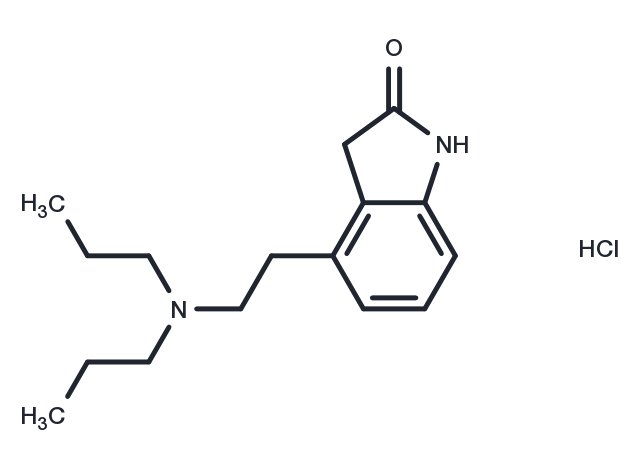Powder: -20°C for 3 years | In solvent: -80°C for 1 year


Ropinirole hydrochloride (SKF-101468A) is a selective dopamine D2 receptors agonist (Ki: 29 nM). Ropinirole hydrochloride (SKF-101468A) is the hydrochloride salt form of ropinirole, a non-ergot dopamine agonist with antiparkinsonian property.

| Pack Size | Availability | Price/USD | Quantity |
|---|---|---|---|
| 25 mg | In stock | $ 36.00 | |
| 50 mg | In stock | $ 52.00 | |
| 100 mg | In stock | $ 79.00 | |
| 200 mg | In stock | $ 107.00 | |
| 500 mg | In stock | $ 177.00 | |
| 1 mL * 10 mM (in DMSO) | In stock | $ 50.00 |



| Description | Ropinirole hydrochloride (SKF-101468A) is a selective dopamine D2 receptors agonist (Ki: 29 nM). Ropinirole hydrochloride (SKF-101468A) is the hydrochloride salt form of ropinirole, a non-ergot dopamine agonist with antiparkinsonian property. |
| Targets&IC50 | D2 receptor:29 nM(Ki) |
| In vitro | Ropinirole scavenges free radicals and suppresses lipid peroxidation in the Fe2+–Water2 reaction system. [2] |
| In vivo | Ropinirole (50 mg/kg, i.p.) causes biphasic spontaneous locomotor activity in mice. Ropinirole (0.05-1.0 mg/kg SC) dose-dependently inhibits the dyskinesias induced by 2-di-n-propylamino-5,6-di-hydroxytetralin in mice. Ropirtirole, at doses of 1 and 10 μg, injected unilaterally directly into the striatum of the rat causes marked, contralateral (away from the side of injection) asymmetry and circling in mice. Ropinirole (0.05-1.0 mg/kg SC or 0.1 mg/kg PO) reverses all motor and behavioural deficits induced by MPTP in marmosets. [1] Ropinirole (2 mg/kg, i.p.) for 7 days increases GSH, catalase and SOD activities in the striatum and protected striatal dopaminergic neurons against 6-hydroxydopamine (6-OHDA) in mice. [2] Ropinirole (0.2 mg/kg, i.p.) improves the use of previously akinetic forelimb and produced robust circling behavior in lesioned rats with striatal over-expression of both D2R and D3R compared to lesioned animals that received blank vector. The subtherapeutic dose of ropinirole generates only modest motor effects in lesioned rats with sole over-expression of D2R or D3R. [3] Ropinirole (1-8 mg t.i.d.) is rapidly and completely absorbed with oral bioavailability of 55%, clearance of 780 mL/min, elimination half-life of 6 hours in healthy volunteer. Since the major route of elimination for Ropinirole is by the CYP enzyme system, mainly by CYP1A2 and also by CYP3A4, inhibition of the former and possibly the latter may reduce the agent's clearance and lead to drug accumulation. [4] Ropinirole (0.25 mg-4.0 mg per day) treatment significantly improves patients' ability to initiate sleep, the amount of stage 2 sleep and sleep adequacy compared with placebo. Periodic limb movements with arousal per hour decreases from 7.0 to 2.5 with ropinirole but increases from 4.2 to 6.0 with placebo. Periodic limb movements while awake per hour decreases from 56.5 to 23.6 with ropinirole but increases from 46.6 to 56.1 with placebo. [5] |
| Kinase Assay | PARP1 enzyme activity is measured by using a commercial assay kit with the exception that cell lysates containing wild-type PARP1 or PARP Y907 mutant are used in place of the PARP1 protein included with the kit. Total lysate (500 ng) is added to each reaction. The dose course of PARP inhibitor Veliparib (ABT-888) is from 0.01 to 1,000 μM. PARP enzyme activity of wild-type and mutants is determined after incubation with the substrate is measured using a plate reader[2]. |
| Synonyms | SKF 101468 hydrochloride, SKF-101468A, Ropinirole HCl |
| Molecular Weight | 296.84 |
| Formula | C16H24N2O·HCl |
| CAS No. | 91374-20-8 |
Powder: -20°C for 3 years | In solvent: -80°C for 1 year
DMSO: 14.8 mg/mL (50 mM)
H2O: 29.7 mg/mL (100 mM)
You can also refer to dose conversion for different animals. More
bottom
Please see Inhibitor Handling Instructions for more frequently ask questions. Topics include: how to prepare stock solutions, how to store products, and cautions on cell-based assays & animal experiments, etc.
Ropinirole hydrochloride 91374-20-8 GPCR/G Protein Neuroscience Dopamine Receptor Parkinson's disease SKF-101468 inhibit Inhibitor Ropinirole Hydrochloride SKF 101468 SKF 101468 hydrochloride SKF-101468A Ropinirole HCl SKF 101468 Hydrochloride SKF101468 Hydrochloride Ropinirole SKF101468 SKF-101468 Hydrochloride inhibitor
